- Home
- Blog
- Web Design Color: The Next Limited Resource?
Color: The Next Limited Resource?
-
 7 min. read
7 min. read
-
 William Craig
William Craig CEO & Co-Founder
CEO & Co-Founder
- President of WebFX. Bill has over 25 years of experience in the Internet marketing industry specializing in SEO, UX, information architecture, marketing automation and more. William’s background in scientific computing and education from Shippensburg and MIT provided the foundation for MarketingCloudFX and other key research and development projects at WebFX.
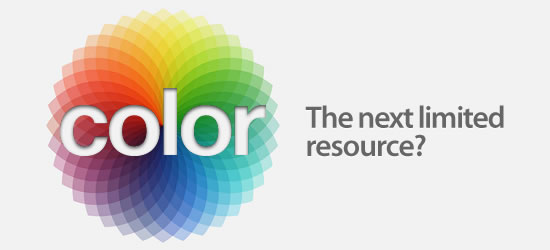 As a designer, it is important to be aware of the trending colors, and how they are being applied in products and work produced today. What really isn’t being discussed by the design world at large though are the limitations being set on color. Color is as free for us to use as the air we breathe…
As a designer, it is important to be aware of the trending colors, and how they are being applied in products and work produced today. What really isn’t being discussed by the design world at large though are the limitations being set on color. Color is as free for us to use as the air we breathe…
or is it? The color palette is shrinking. It could affect the foundation of design for everything from websites to fashion. The fate of businesses and billions of dollars ride on choosing the right one.
We’ll take a look at how color is becoming the next limited resource.
Limit: One Spectrum per World
Color is limited by what our eyes can see. It’s the visible light spectrum (wavelengths of light) our eyes can detect. On one end of the spectrum lies red (longer wavelengths) and on the other blue (shorter wavelengths); everything in between those are the colors we find in nature.
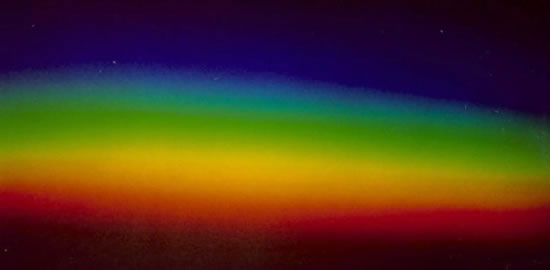 The visible spectrum. Although this spectrum we have available is limited, we still do have a lot of choice when it comes to color. We attempt to reproduce this spectrum in printing, monitors, paintings, and so on. The difference in the way a monitor displays color versus a printed brochure is a world away and more technical than most people would want to worry themselves with.
The visible spectrum. Although this spectrum we have available is limited, we still do have a lot of choice when it comes to color. We attempt to reproduce this spectrum in printing, monitors, paintings, and so on. The difference in the way a monitor displays color versus a printed brochure is a world away and more technical than most people would want to worry themselves with.
One company is responsible for connecting this vast chasm of color. Pantone.
Color by Any Other Name Would Be Pantone
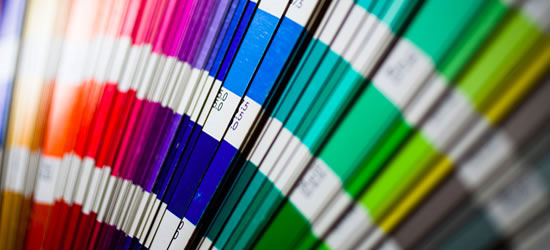 If there is anyone that could say they own color, it would be Pantone.
If there is anyone that could say they own color, it would be Pantone.
They have a monopoly on it in the truest sense. Every color you have ever seen used has been indexed and named by Pantone. What Pantone has done is not a bad thing; in fact, it has done the world (especially designers) a favor. They have taken color from a chaotic Tower of Babel scenario with everyone talking about colors in very different ways and brought us all on to the same page.
Literally. Their paint chip and fabric swatch books sit on the desks of designers everywhere. Pantone’s system allows for a design agency in Chicago to make sure the color they specified for a brand is printed accurately in a magazine by publication in Europe, and looks the same in television spot being created by a firm in Los Angeles.
As J.C. Herz of Wiredput it, “If color is a language, Pantone is the Oxford English Dictionary.”
The Battle for Color
For companies, color has become one of the most important identifiers. More often than not, colors are how you recognize and associate products to that brand.
Marketing research has found 80% of visual information is related to color. It’s not just a green, a red, a blue, or a magenta. It’s “Starbucks Green”, “Coke Red”, “Gap Blue”, and “T-Mobile Magenta.” 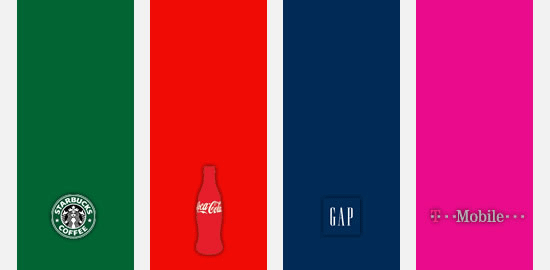 Separating colors from their brands is close to impossible. The inseparable color and brand association (above) have become a legal reality.
Separating colors from their brands is close to impossible. The inseparable color and brand association (above) have become a legal reality.
Brands are putting a stake in the spectrum and claiming that color for their own use. An infographic of what this looks like was in Wired magazine in June of 2003. 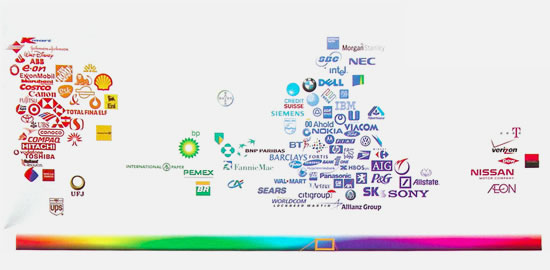 Wired infographic showing the “color location” of the world’s biggest brands.
Wired infographic showing the “color location” of the world’s biggest brands.
T-Mobile owns the color Magenta
The most interesting and polemic story of a brand buying and claiming a color space is with T-Mobile (Deutsche Telekom). They have trademarked the color magenta. Yes, T-Mobile owns the rights to magenta.
They have been enforcing this over the years suing companies like a book-on-demand publisher, and most recently, in the blog Engadget Mobile. 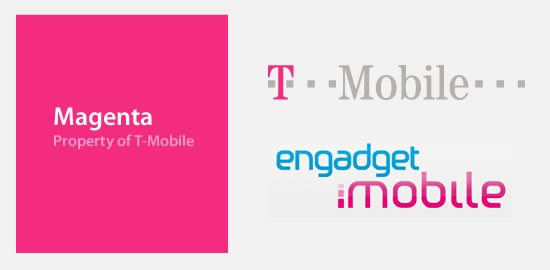 To clarify, companies like T-mobile can only trademark in the industry sector that they are registered in. So T-Mobile has trademarked the color magenta in telecommunications.
To clarify, companies like T-mobile can only trademark in the industry sector that they are registered in. So T-Mobile has trademarked the color magenta in telecommunications.
The blog COLOURLovers says that this means, “you just can’t use the color magenta around anything to do with phones, digital media… oh and just about anything on the internet.”
What’s in a name?
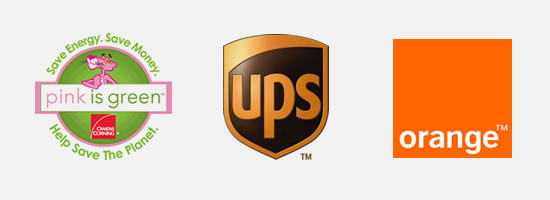 In addition to a trademarked color, some companies are also trademarking the actual name of the color. The insulation company Owens–Corning, known for their The Pink Panther commercials, have registered the term “PINK” (in capital letters only) in reference to its insulation.
In addition to a trademarked color, some companies are also trademarking the actual name of the color. The insulation company Owens–Corning, known for their The Pink Panther commercials, have registered the term “PINK” (in capital letters only) in reference to its insulation.
UPS is one of the best-known companies of the world, shipping us our goods ordered from across the world to our doorstep. They trademarked the slogan “What can Brown do for you?” The Europe-based mobile network operator and internet service provider, Orange, uses the color Orange both in its logo and as the trademarked company name.
The Color of Money
Not only are companies trademarking existing colors, but they are producing new colors, naming them, and trademarking them.
Jay-Z, the hip-hop artist and entrepreneur, collaborated with the car company GMC to do just that. Together with GMC’s Global Color Studio, they produced a blue hue called “Jay-Z Blue.” It was used on the 2007 GMC Yukon Denali. 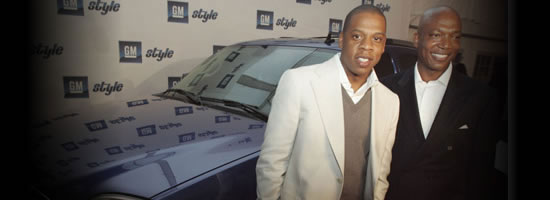 Jay-Z debuts the 2007 GMC Yukon Denali painted with his “Jay-Z Blue” color. This idea of mixing a color and patenting it is not entirely new.
Jay-Z debuts the 2007 GMC Yukon Denali painted with his “Jay-Z Blue” color. This idea of mixing a color and patenting it is not entirely new.
The French artist, Yves Klein (known for minimalist monochromatic paintings), primarily started using his signature mixed blue in 1958. It is called International Klein Blue (IKB) and has been used in the fashion world.
Who owns color?
These trends in limiting color usage and the rights that brands have to trademark colors is a difficult road to navigate. Not everyone is well versed in trademark laws and intellectual property rights.
On one side, companies need to protect their brand identity, which they’ve invested much capital into. On the other side, there are designers and artists trying to create great work with a limited color palette. There of course is a fear that at some point, the best color hues will have been claimed and there would be no other good colors left to design with.
How likely is this scenario? As likely as anyone would have imagined being sued by T-mobile for using the color magenta.
Credits
- spectrum #2 used in the leading image by Ole Martin Buene.
- Skylights used to illustrate the color spectrum.
- pantone_7oct2009_0995 by Patrick Lauke.
Related Content
-
 President of WebFX. Bill has over 25 years of experience in the Internet marketing industry specializing in SEO, UX, information architecture, marketing automation and more. William’s background in scientific computing and education from Shippensburg and MIT provided the foundation for MarketingCloudFX and other key research and development projects at WebFX.
President of WebFX. Bill has over 25 years of experience in the Internet marketing industry specializing in SEO, UX, information architecture, marketing automation and more. William’s background in scientific computing and education from Shippensburg and MIT provided the foundation for MarketingCloudFX and other key research and development projects at WebFX. -

WebFX is a full-service marketing agency with 1,100+ client reviews and a 4.9-star rating on Clutch! Find out how our expert team and revenue-accelerating tech can drive results for you! Learn more
Make estimating web design costs easy
Website design costs can be tricky to nail down. Get an instant estimate for a custom web design with our free website design cost calculator!
Try Our Free Web Design Cost Calculator


Web Design Calculator
Use our free tool to get a free, instant quote in under 60 seconds.
View Web Design CalculatorMake estimating web design costs easy
Website design costs can be tricky to nail down. Get an instant estimate for a custom web design with our free website design cost calculator!
Try Our Free Web Design Cost Calculator





